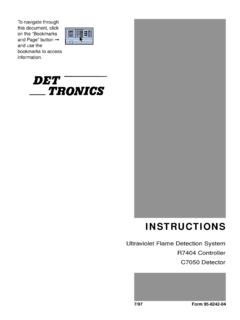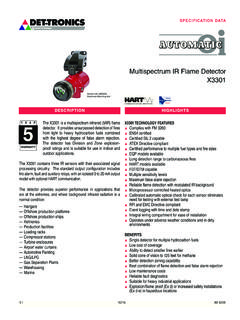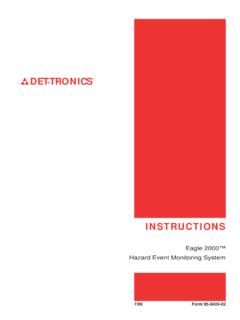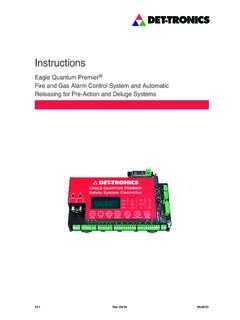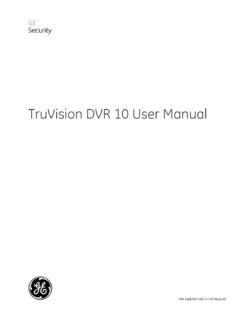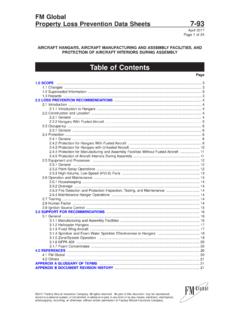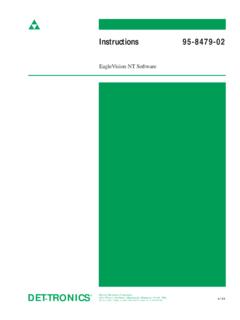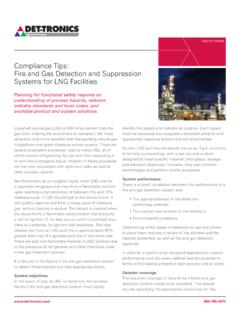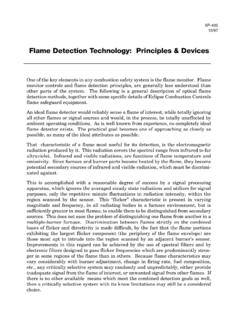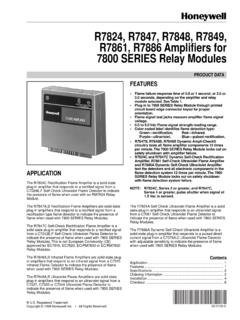Transcription of Ultraviolet/Infrared Test Lamp W867 - Det-Tronics
1 APPLICATIONThe Det-Tronics w867 Ultraviolet/Infrared (UV/IR) Test lamp is a portable, battery operated source of ultraviolet and infrared radiation that can be used for periodic inspection of UV, single frequency IR and UV/IR flame detection systems. It produces UV and IR radiation to verify response of the flame detection system without the need for an open flame, and is suitable for use in hazardous (classified) areas. (Note: Det-Tronics Dual Frequency IR detectors require the model W868 Dual Frequency IR Test lamp for testing.)SPECIFICATIONSENCLOSURE Cast Class I, Division 1, Groups C and D;Class II, Division 1, Groups E, F and storage and use in dry or damp locations RATINGS Battery Charger Input Voltage: 120 volts ac, 60 Hz 220 volts ac, 50 Hz (optional).
2 TEMPERATURE RANGE Operating: +5 F to +122 F ( 15 C to +50 C).Charge: +32 F to +104 F (0 C to +40 C).Storage: +5 F to +104 F ( 15 C to +40 C).OPERATING TIME Approximately 15 minutes continuous between recharges. This will vary with the ambient Broadband emissions in both UV and IR OPERATING RANGE UV detector (25 cps sensitivity setting): >50 feet (15 meters).IR detector (40 cps sensitivity setting): 5 feet ( meters).UV/IR detector (16 cps sensitivity setting): 5 feet ( meters).DIMENSIONS See Figure (APPROXIMATE) 14 pounds ( kg).INSTRUCTIONSU ltraviolet/ infrared Test Detector Electronics Corporation 2007 9/07 to ultraviolet radiation from the w867 Test lamp can be damaging to the eyes.
3 Do not look directly into the window of the test lamp when it is operate the w867 Test lamp , push the ON button (see Figure 2) and aim the test lamp at the detector. The UV and IR emitting lamp inside the w867 will flash on and off at a rate of approximately 2 times per second. This flashing operation satisfies the flicker circuit in the IR detector. Response of the detection system will depend upon the distance between the w867 and the detector, and upon the sensitivity programmed into the detection system. It may be necessary to decrease the distance between the detector and the test lamp in order to obtain a response.
4 Do not operate the test lamp longer than is necessary to actuate the detector. Each detector can be checked with less than 30 seconds of operating time. It is important to avoid discharging the battery to the point where the battery charge level Indicating LED (see Figure 2) is on steady. Refer to the Battery Maintenance section of these instructions for further not remove the shock insulators from the lens cap or battery storage ( ) ( ) ( ) ( ) ( ) ( )TOP VIEWSIDE VIEWF igure 1 w867 Test lamp Dimensions in inches (cm)A1714 WINDOWED PLUGON PUSHBUTTONHANDLEINDICATING LEDCHARGER CABLE CONNECTIONF igure 2 Top View of w867 Test CHECKOUTA system checkout should be performed after installation is complete.
5 A periodic maintenance checkout (with minimum frequency of once every six months) should be scheduled to ensure that the system is in proper operating condition. Depending on the degree of hazard and the amount of contaminants in the atmosphere, the checkout can be scheduled more often. Note that oil films will significantly reduce the transmission of ultraviolet radiation through the detector specific system checkout instructions, see the Checkout Procedure section of the instruction manual for the flame detection system being w867 Test lamp is a safe, portable UV/IR source for external testing and verification of the response of Det-Tronics UV, single frequency IR, and UV/IR detectors.
6 It is suitable for use in hazardous (classified) areas, but is not a substitute for an actual open flame PROCEDURESBATTERY MAINTENANCEA battery charge level indicating LED and the charger cable connection for recharging the battery are located beneath a removable windowed plug in front of the ON pushbutton switch. See Figure 2. To maintain the explosion-proof rating of the w867 , the plug must be installed whenever the battery is not being charged. To determine the battery charge level, press the ON pushbutton and observe the Indicating LED. When the battery is fully charged, the red Indicating LED (viewed through the window) is off.
7 When the battery reaches a marginal level, the Indicating LED will flash on and off. The battery should be recharged at this time. If the Indicating LED is on continuously, the battery is at a very low level and the test lamp should not be operated until the battery has been recharged. WARNINGThe life of the battery is significantly reduced if it is operated when the red LED is on 12 volt dc, ampere battery charger is provided to supply dc voltage from an ac outlet for recharging the w867 battery. Battery chargers are available to operate on either 120 vac 60 Hz or 220 vac 50 Hz (optional).
8 This plug-in battery charger contains a Power On LED to indicate when the charger is plugged in and a Fast Charge LED to indicate when the battery is being charged. WARNINGDo not operate the w867 Test lamp when the battery is charging. Do not recharge the battery in a hazardous recharge the battery, first remove the windowed plug to gain access to the recharge connection. Plug the charger cable plug into the battery. Plug the battery charger into the appropriate ac outlet. The Power On and Fast Charge LEDs on the battery charger should be on. When the battery is fully charged, the Fast Charge LED will go out.
9 This should take from 12 to 14 hours from a discharged return the w867 Test lamp to service, unplug the battery charger from the ac outlet. Disconnect the charger cable from the battery. Replace the windowed plug. Press the ON pushbutton and observe the indicating LED on the battery. The indicating LED should be off, which shows that the battery is fully charged and ready to operate. DEVICE REPAIR AND RETURNThe w867 UV/IR Test lamp is not designed to be repaired in the field. If the test lamp fails to operate after fully charging the battery, return it to the factory for to returning devices, contact the nearest localDetector Electronics office so that a Return MaterialIdentification (RMI) number can be assigned.
10 Awritten statement describing the malfunction mustaccompany the returned device or component toassist and expedite finding the root cause of the unit properly. Always use sufficient packing material in addition to an antistatic bag as protection from electrostatic packaging that ultimately causesdamage to the returned device during shipmentwill result in a service charge to repair the damageincurred during all equipment transportation prepaid to the factory in INFORMATIONWhen ordering, specify:Part Number Description004000-003 W867C3001 - 120 VAC004000-004 W867C3002 - 220 VAC; 2 pin, Euro004000-005 W867C3003 - 220 VAC.

